Alfa Romeo 4C 2014 Owner handbook (in English)
Manufacturer: ALFA ROMEO, Model Year: 2014, Model line: 4C, Model: Alfa Romeo 4C 2014Pages: 190, PDF Size: 7.87 MB
Page 41 of 190
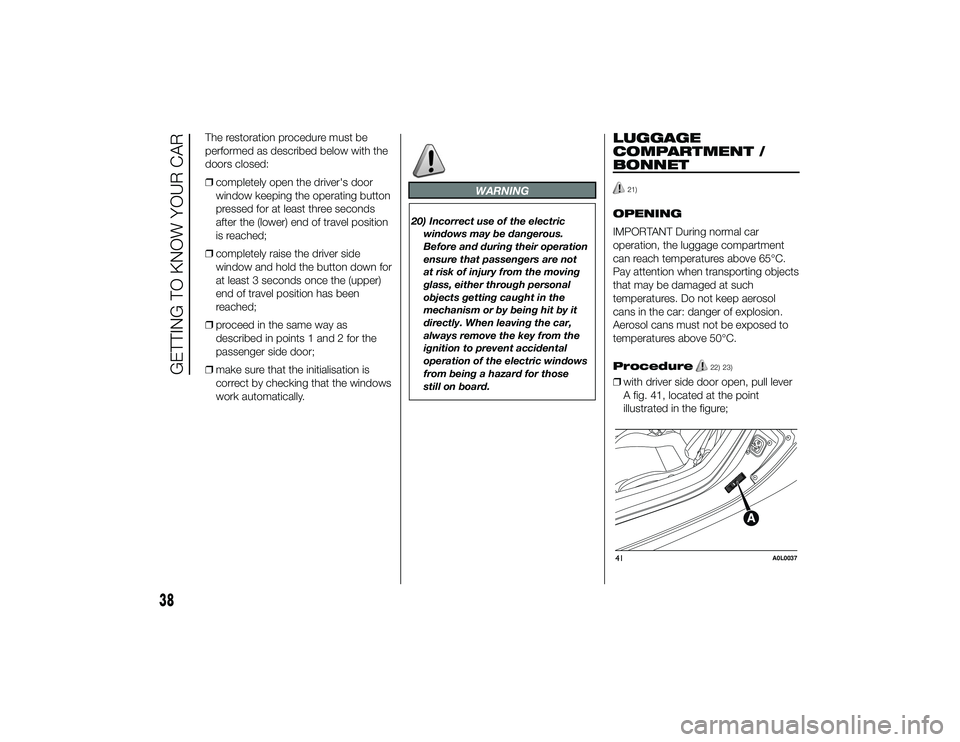
The restoration procedure must be
performed as described below with the
doors closed:
❒completely open the driver's door
window keeping the operating button
pressed for at least three seconds
after the (lower) end of travel position
is reached;
❒ completely raise the driver side
window and hold the button down for
at least 3 seconds once the (upper)
end of travel position has been
reached;
❒ proceed in the same way as
described in points 1 and 2 for the
passenger side door;
❒ make sure that the initialisation is
correct by checking that the windows
work automatically.
WARNING
20) Incorrect use of the electric
windows may be dangerous.
Before and during their operation
ensure that passengers are not
at risk of injury from the moving
glass, either through personal
objects getting caught in the
mechanism or by being hit by it
directly. When leaving the car,
always remove the key from the
ignition to prevent accidental
operation of the electric windows
from being a hazard for those
still on board.
LUGGAGE
COMPARTMENT /
BONNET
21)
OPENING
IMPORTANT During normal car
operation, the luggage compartment
can reach temperatures above 65°C.
Pay attention when transporting objects
that may be damaged at such
temperatures. Do not keep aerosol
cans in the car: danger of explosion.
Aerosol cans must not be exposed to
temperatures above 50°C.
Procedure
22) 23)
❒with driver side door open, pull lever
A fig. 41, located at the point
illustrated in the figure;41
A0L0037
38
GETTING TO KNOW YOUR CAR
24-9-2013 11:49 Pagina 38
Page 42 of 190
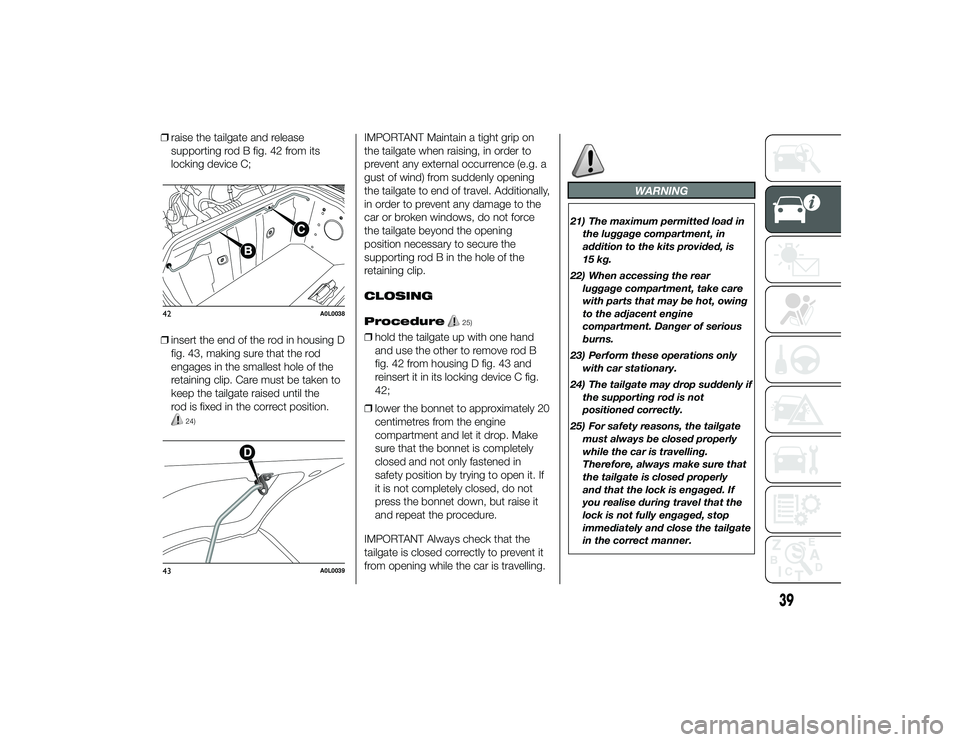
❒raise the tailgate and release
supporting rod B fig. 42 from its
locking device C;
❒ insert the end of the rod in housing D
fig. 43, making sure that the rod
engages in the smallest hole of the
retaining clip. Care must be taken to
keep the tailgate raised until the
rod is fixed in the correct position.
24)
IMPORTANT Maintain a tight grip on
the tailgate when raising, in order to
prevent any external occurrence (e.g. a
gust of wind) from suddenly opening
the tailgate to end of travel. Additionally,
in order to prevent any damage to the
car or broken windows, do not force
the tailgate beyond the opening
position necessary to secure the
supporting rod B in the hole of the
retaining clip.
CLOSING
Procedure
25)
❒hold the tailgate up with one hand
and use the other to remove rod B
fig. 42 from housing D fig. 43 and
reinsert it in its locking device C fig.
42;
❒ lower the bonnet to approximately 20
centimetres from the engine
compartment and let it drop. Make
sure that the bonnet is completely
closed and not only fastened in
safety position by trying to open it. If
it is not completely closed, do not
press the bonnet down, but raise it
and repeat the procedure.
IMPORTANT Always check that the
tailgate is closed correctly to prevent it
from opening while the car is travelling.
WARNING
21) The maximum permitted load in the luggage compartment, in
addition to the kits provided, is
15 kg.
22) When accessing the rear luggage compartment, take care
with parts that may be hot, owing
to the adjacent engine
compartment. Danger of serious
burns.
23) Perform these operations only with car stationary.
24) The tailgate may drop suddenly if the supporting rod is not
positioned correctly.
25) For safety reasons, the tailgate must always be closed properly
while the car is travelling.
Therefore, always make sure that
the tailgate is closed properly
and that the lock is engaged. If
you realise during travel that the
lock is not fully engaged, stop
immediately and close the tailgate
in the correct manner.
42
A0L0038
43
A0L0039
39
24-9-2013 11:49 Pagina 39
Page 43 of 190
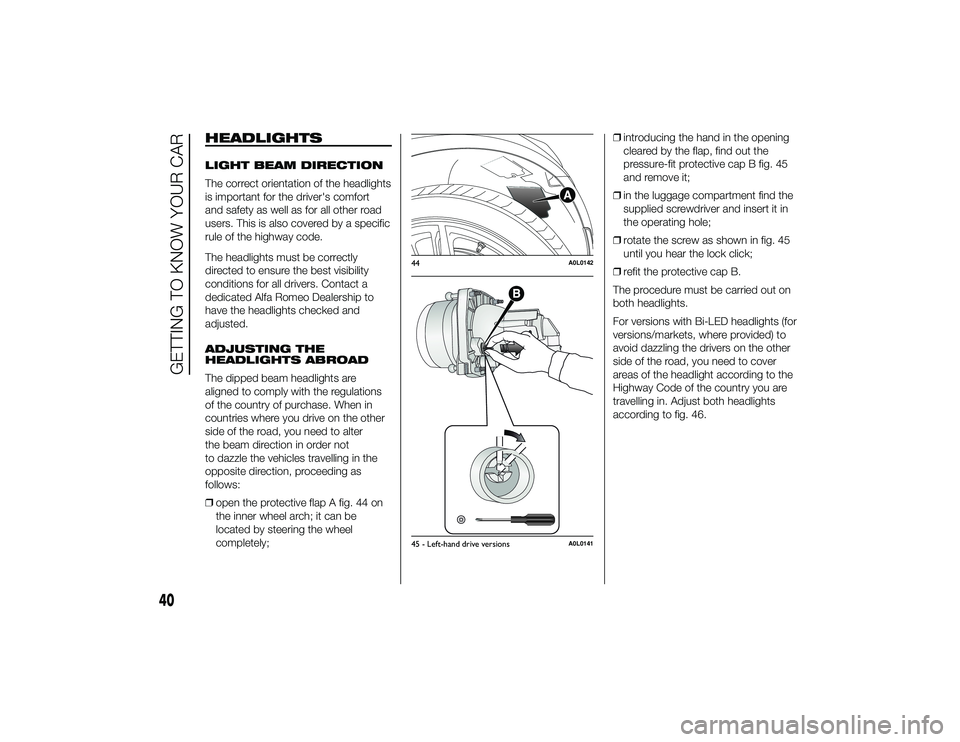
HEADLIGHTSLIGHT BEAM DIRECTION
The correct orientation of the headlights
is important for the driver's comfort
and safety as well as for all other road
users. This is also covered by a specific
rule of the highway code.
The headlights must be correctly
directed to ensure the best visibility
conditions for all drivers. Contact a
dedicated Alfa Romeo Dealership to
have the headlights checked and
adjusted.
ADJUSTING THE
HEADLIGHTS ABROAD
The dipped beam headlights are
aligned to comply with the regulations
of the country of purchase. When in
countries where you drive on the other
side of the road, you need to alter
the beam direction in order not
to dazzle the vehicles travelling in the
opposite direction, proceeding as
follows:
❒open the protective flap A fig. 44 on
the inner wheel arch; it can be
located by steering the wheel
completely; ❒
introducing the hand in the opening
cleared by the flap, find out the
pressure-fit protective cap B fig. 45
and remove it;
❒ in the luggage compartment find the
supplied screwdriver and insert it in
the operating hole;
❒ rotate the screw as shown in fig. 45
until you hear the lock click;
❒ refit the protective cap B.
The procedure must be carried out on
both headlights.
For versions with Bi-LED headlights (for
versions/markets, where provided) to
avoid dazzling the drivers on the other
side of the road, you need to cover
areas of the headlight according to the
Highway Code of the country you are
travelling in. Adjust both headlights
according to fig. 46.
44
A0L0142
45 - Left-hand drive versions
A0L0141
40
GETTING TO KNOW YOUR CAR
24-9-2013 11:49 Pagina 40
Page 44 of 190
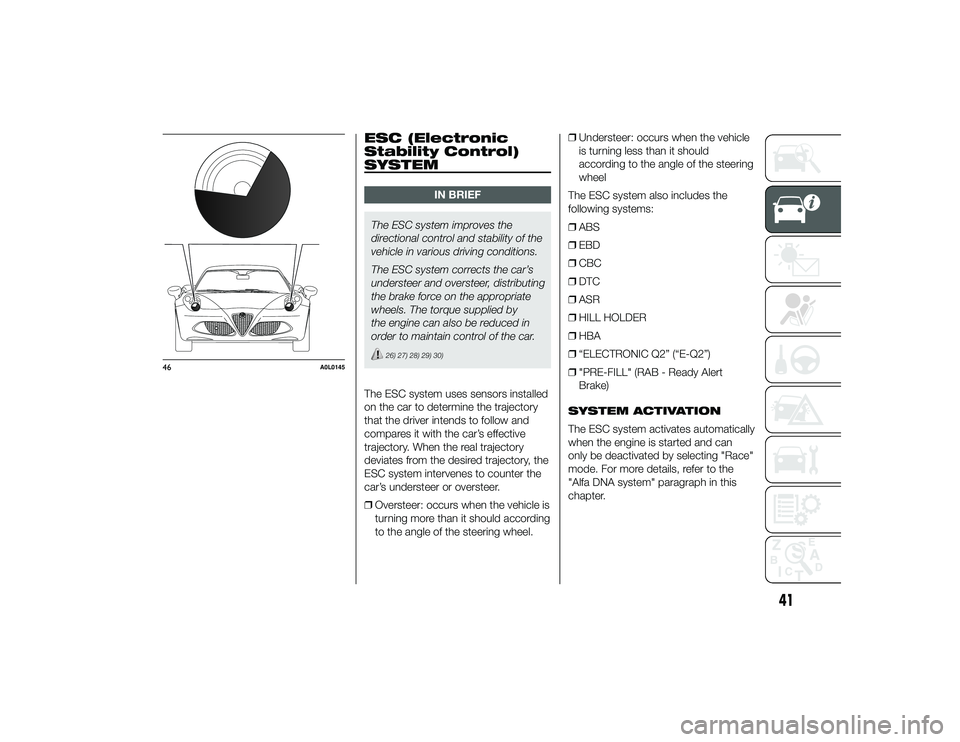
ESC (Electronic
Stability Control)
SYSTEM
IN BRIEF
The ESC system improves the
directional control and stability of the
vehicle in various driving conditions.
The ESC system corrects the car’s
understeer and oversteer, distributing
the brake force on the appropriate
wheels. The torque supplied by
the engine can also be reduced in
order to maintain control of the car.
26) 27) 28) 29) 30)
The ESC system uses sensors installed
on the car to determine the trajectory
that the driver intends to follow and
compares it with the car’s effective
trajectory. When the real trajectory
deviates from the desired trajectory, the
ESC system intervenes to counter the
car’s understeer or oversteer.
❒ Oversteer: occurs when the vehicle is
turning more than it should according
to the angle of the steering wheel. ❒
Understeer: occurs when the vehicle
is turning less than it should
according to the angle of the steering
wheel
The ESC system also includes the
following systems:
❒ ABS
❒ EBD
❒ CBC
❒ DTC
❒ ASR
❒ HILL HOLDER
❒ HBA
❒ “ELECTRONIC Q2” (“E-Q2”)
❒ "PRE-FILL" (RAB - Ready Alert
Brake)
SYSTEM ACTIVATION
The ESC system activates automatically
when the engine is started and can
only be deactivated by selecting "Race"
mode. For more details, refer to the
"Alfa DNA system" paragraph in this
chapter.
46
A0L0145
41
24-9-2013 11:49 Pagina 41
Page 45 of 190
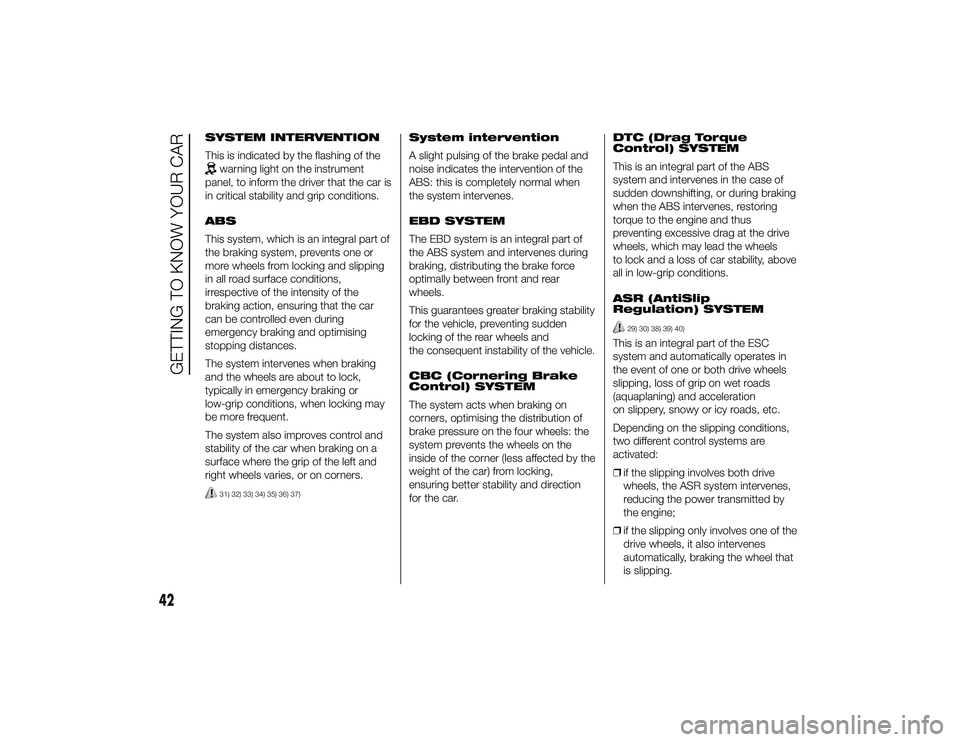
SYSTEM INTERVENTION
This is indicated by the flashing of the
warning light on the instrument
panel, to inform the driver that the car is
in critical stability and grip conditions.
ABS
This system, which is an integral part of
the braking system, prevents one or
more wheels from locking and slipping
in all road surface conditions,
irrespective of the intensity of the
braking action, ensuring that the car
can be controlled even during
emergency braking and optimising
stopping distances.
The system intervenes when braking
and the wheels are about to lock,
typically in emergency braking or
low-grip conditions, when locking may
be more frequent.
The system also improves control and
stability of the car when braking on a
surface where the grip of the left and
right wheels varies, or on corners.31) 32) 33) 34) 35) 36) 37)
System intervention
A slight pulsing of the brake pedal and
noise indicates the intervention of the
ABS: this is completely normal when
the system intervenes.
EBD SYSTEM
The EBD system is an integral part of
the ABS system and intervenes during
braking, distributing the brake force
optimally between front and rear
wheels.
This guarantees greater braking stability
for the vehicle, preventing sudden
locking of the rear wheels and
the consequent instability of the vehicle.
CBC (Cornering Brake
Control) SYSTEM
The system acts when braking on
corners, optimising the distribution of
brake pressure on the four wheels: the
system prevents the wheels on the
inside of the corner (less affected by the
weight of the car) from locking,
ensuring better stability and direction
for the car. DTC (Drag Torque
Control) SYSTEM
This is an integral part of the ABS
system and intervenes in the case of
sudden downshifting, or during braking
when the ABS intervenes, restoring
torque to the engine and thus
preventing excessive drag at the drive
wheels, which may lead the wheels
to lock and a loss of car stability, above
all in low-grip conditions.
ASR (AntiSlip
Regulation) SYSTEM
29) 30) 38) 39) 40)
This is an integral part of the ESC
system and automatically operates in
the event of one or both drive wheels
slipping, loss of grip on wet roads
(aquaplaning) and acceleration
on slippery, snowy or icy roads, etc.
Depending on the slipping conditions,
two different control systems are
activated:
❒
if the slipping involves both drive
wheels, the ASR system intervenes,
reducing the power transmitted by
the engine;
❒ if the slipping only involves one of the
drive wheels, it also intervenes
automatically, braking the wheel that
is slipping.
42
GETTING TO KNOW YOUR CAR
24-9-2013 11:49 Pagina 42
Page 46 of 190
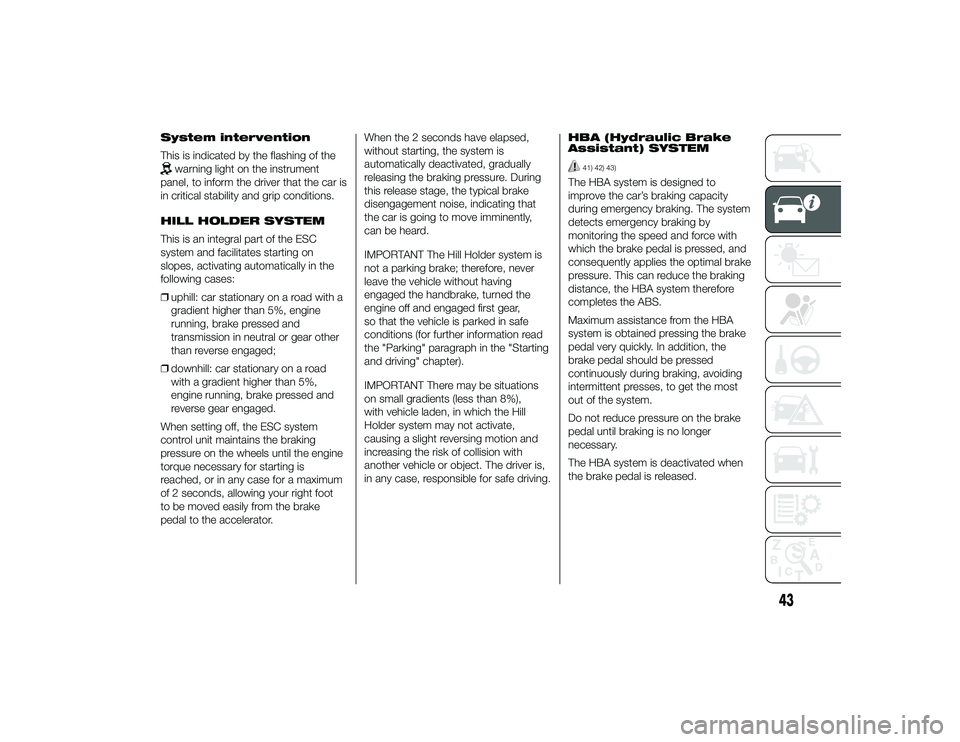
System intervention
This is indicated by the flashing of the
warning light on the instrument
panel, to inform the driver that the car is
in critical stability and grip conditions.
HILL HOLDER SYSTEM
This is an integral part of the ESC
system and facilitates starting on
slopes, activating automatically in the
following cases:
❒ uphill: car stationary on a road with a
gradient higher than 5%, engine
running, brake pressed and
transmission in neutral or gear other
than reverse engaged;
❒ downhill: car stationary on a road
with a gradient higher than 5%,
engine running, brake pressed and
reverse gear engaged.
When setting off, the ESC system
control unit maintains the braking
pressure on the wheels until the engine
torque necessary for starting is
reached, or in any case for a maximum
of 2 seconds, allowing your right foot
to be moved easily from the brake
pedal to the accelerator. When the 2 seconds have elapsed,
without starting, the system is
automatically deactivated, gradually
releasing the braking pressure. During
this release stage, the typical brake
disengagement noise, indicating that
the car is going to move imminently,
can be heard.
IMPORTANT The Hill Holder system is
not a parking brake; therefore, never
leave the vehicle without having
engaged the handbrake, turned the
engine off and engaged first gear,
so that the vehicle is parked in safe
conditions (for further information read
the "Parking" paragraph in the "Starting
and driving" chapter).
IMPORTANT There may be situations
on small gradients (less than 8%),
with vehicle laden, in which the Hill
Holder system may not activate,
causing a slight reversing motion and
increasing the risk of collision with
another vehicle or object. The driver is,
in any case, responsible for safe driving.
HBA (Hydraulic Brake
Assistant) SYSTEM
41) 42) 43)
The HBA system is designed to
improve the car’s braking capacity
during emergency braking. The system
detects emergency braking by
monitoring the speed and force with
which the brake pedal is pressed, and
consequently applies the optimal brake
pressure. This can reduce the braking
distance, the HBA system therefore
completes the ABS.
Maximum assistance from the HBA
system is obtained pressing the brake
pedal very quickly. In addition, the
brake pedal should be pressed
continuously during braking, avoiding
intermittent presses, to get the most
out of the system.
Do not reduce pressure on the brake
pedal until braking is no longer
necessary.
The HBA system is deactivated when
the brake pedal is released.
43
24-9-2013 11:49 Pagina 43
Page 47 of 190
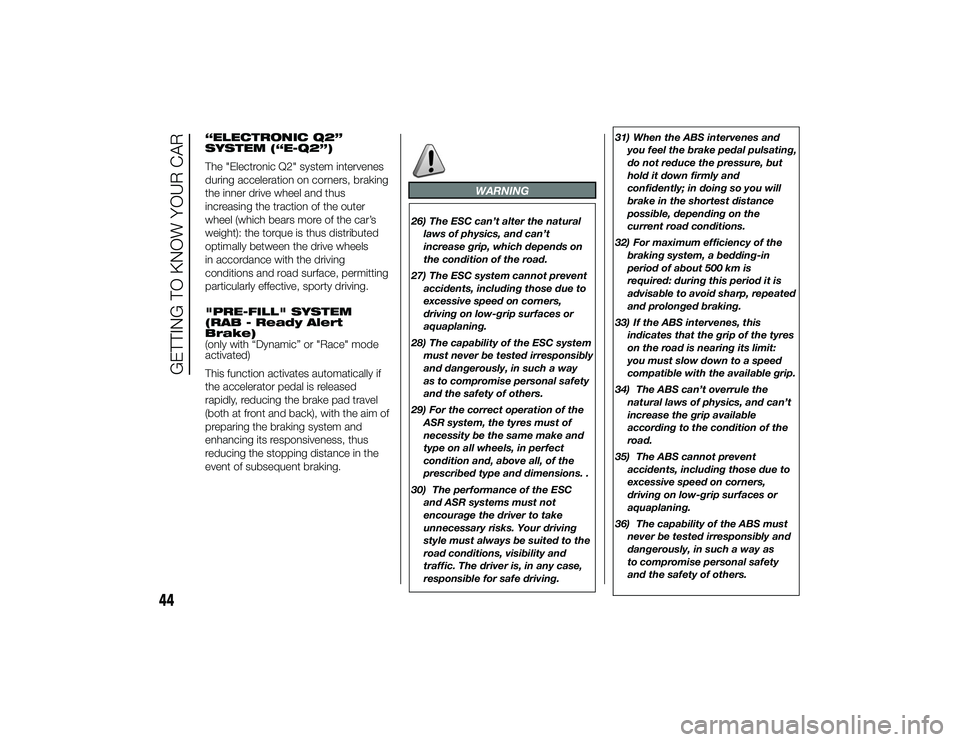
“ELECTRONIC Q2”
SYSTEM (“E-Q2”)
The "Electronic Q2" system intervenes
during acceleration on corners, braking
the inner drive wheel and thus
increasing the traction of the outer
wheel (which bears more of the car’s
weight): the torque is thus distributed
optimally between the drive wheels
in accordance with the driving
conditions and road surface, permitting
particularly effective, sporty driving.
"PRE-FILL" SYSTEM
(RAB - Ready Alert
Brake)
(only with “Dynamic” or "Race" mode
activated)
This function activates automatically if
the accelerator pedal is released
rapidly, reducing the brake pad travel
(both at front and back), with the aim of
preparing the braking system and
enhancing its responsiveness, thus
reducing the stopping distance in the
event of subsequent braking.
WARNING
26) The ESC can’t alter the naturallaws of physics, and can’t
increase grip, which depends on
the condition of the road.
27) The ESC system cannot prevent accidents, including those due to
excessive speed on corners,
driving on low-grip surfaces or
aquaplaning.
28) The capability of the ESC system must never be tested irresponsibly
and dangerously, in such a way
as to compromise personal safety
and the safety of others.
29) For the correct operation of the ASR system, the tyres must of
necessity be the same make and
type on all wheels, in perfect
condition and, above all, of the
prescribed type and dimensions. .
30) The performance of the ESC and ASR systems must not
encourage the driver to take
unnecessary risks. Your driving
style must always be suited to the
road conditions, visibility and
traffic. The driver is, in any case,
responsible for safe driving. 31) When the ABS intervenes and
you feel the brake pedal pulsating,
do not reduce the pressure, but
hold it down firmly and
confidently; in doing so you will
brake in the shortest distance
possible, depending on the
current road conditions.
32) For maximum efficiency of the braking system, a bedding-in
period of about 500 km is
required: during this period it is
advisable to avoid sharp, repeated
and prolonged braking.
33) If the ABS intervenes, this indicates that the grip of the tyres
on the road is nearing its limit:
you must slow down to a speed
compatible with the available grip.
34) The ABS can’t overrule the natural laws of physics, and can’t
increase the grip available
according to the condition of the
road.
35) The ABS cannot prevent accidents, including those due to
excessive speed on corners,
driving on low-grip surfaces or
aquaplaning.
36) The capability of the ABS must never be tested irresponsibly and
dangerously, in such a way as
to compromise personal safety
and the safety of others.
44
GETTING TO KNOW YOUR CAR
24-9-2013 11:49 Pagina 44
Page 48 of 190
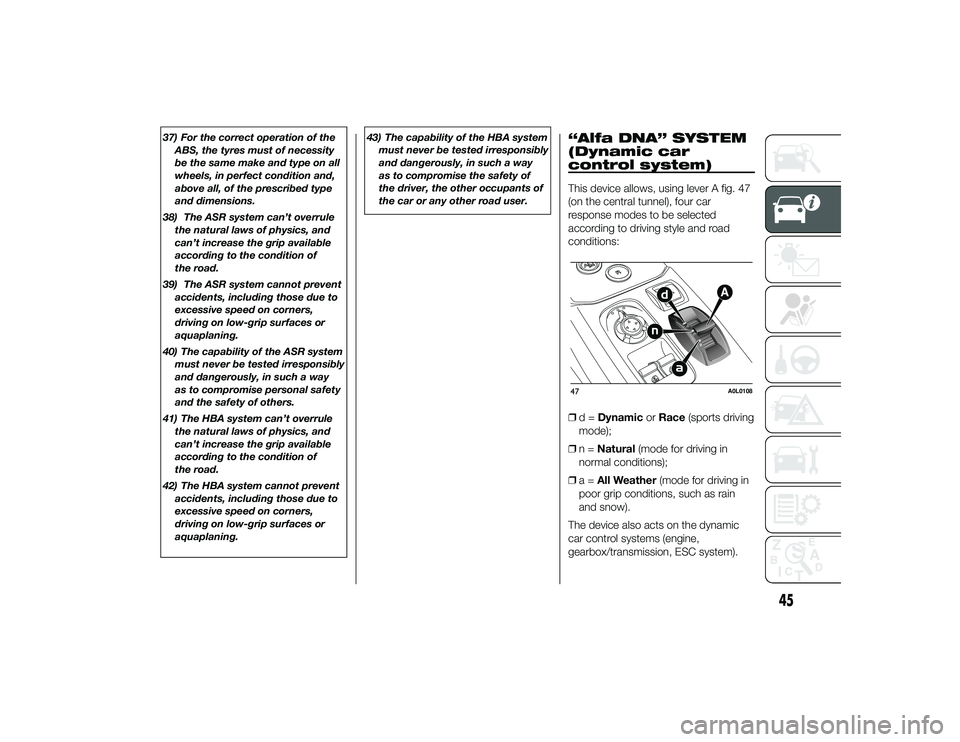
37) For the correct operation of theABS, the tyres must of necessity
be the same make and type on all
wheels, in perfect condition and,
above all, of the prescribed type
and dimensions.
38) The ASR system can’t overrule the natural laws of physics, and
can’t increase the grip available
according to the condition of
the road.
39) The ASR system cannot prevent accidents, including those due to
excessive speed on corners,
driving on low-grip surfaces or
aquaplaning.
40) The capability of the ASR system must never be tested irresponsibly
and dangerously, in such a way
as to compromise personal safety
and the safety of others.
41) The HBA system can’t overrule the natural laws of physics, and
can’t increase the grip available
according to the condition of
the road.
42) The HBA system cannot prevent accidents, including those due to
excessive speed on corners,
driving on low-grip surfaces or
aquaplaning. 43) The capability of the HBA system
must never be tested irresponsibly
and dangerously, in such a way
as to compromise the safety of
the driver, the other occupants of
the car or any other road user.
“Alfa DNA” SYSTEM
(Dynamic car
control system)This device allows, using lever A fig. 47
(on the central tunnel), four car
response modes to be selected
according to driving style and road
conditions:
❒d=Dynamic orRace (sports driving
mode);
❒ n=Natural (mode for driving in
normal conditions);
❒ a=All Weather (mode for driving in
poor grip conditions, such as rain
and snow).
The device also acts on the dynamic
car control systems (engine,
gearbox/transmission, ESC system).47
A0L0108
45
24-9-2013 11:49 Pagina 45
Page 49 of 190
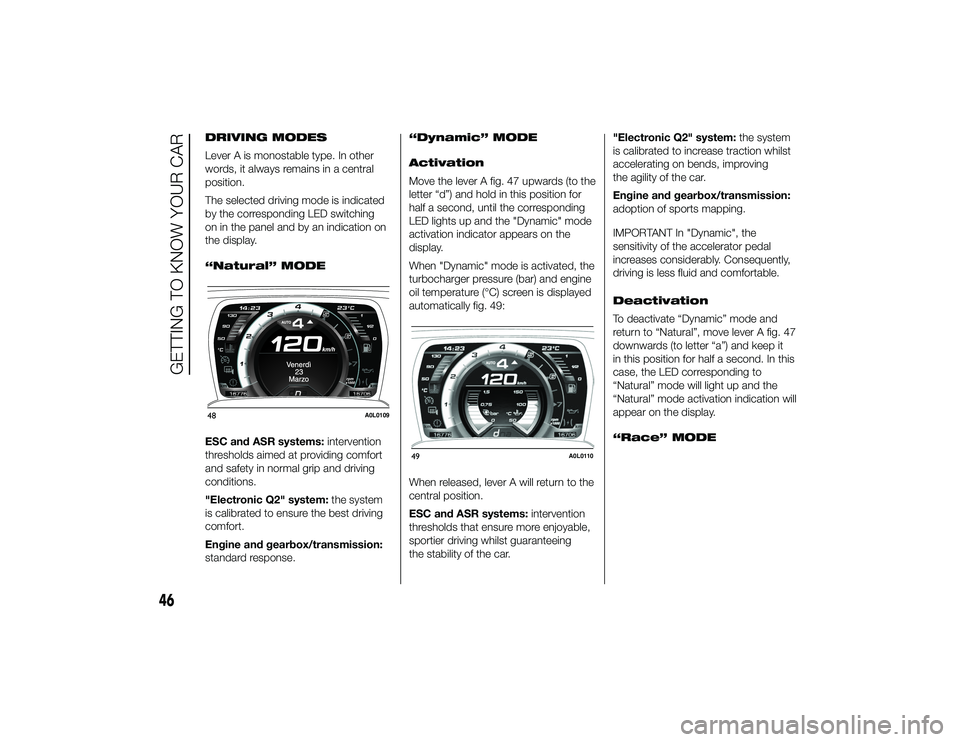
DRIVING MODES
Lever A is monostable type. In other
words, it always remains in a central
position.
The selected driving mode is indicated
by the corresponding LED switching
on in the panel and by an indication on
the display.
“Natural” MODE
ESC and ASR systems:intervention
thresholds aimed at providing comfort
and safety in normal grip and driving
conditions.
"Electronic Q2" system: the system
is calibrated to ensure the best driving
comfort.
Engine and gearbox/transmission:
standard response. “Dynamic” MODE
Activation
Move the lever A fig. 47 upwards (to the
letter “d”) and hold in this position for
half a second, until the corresponding
LED lights up and the "Dynamic" mode
activation indicator appears on the
display.
When "Dynamic" mode is activated, the
turbocharger pressure (bar) and engine
oil temperature (°C) screen is displayed
automatically fig. 49:
When released, lever A will return to the
central position.
ESC and ASR systems:
intervention
thresholds that ensure more enjoyable,
sportier driving whilst guaranteeing
the stability of the car. "Electronic Q2" system:
the system
is calibrated to increase traction whilst
accelerating on bends, improving
the agility of the car.
Engine and gearbox/transmission:
adoption of sports mapping.
IMPORTANT In "Dynamic", the
sensitivity of the accelerator pedal
increases considerably. Consequently,
driving is less fluid and comfortable.
Deactivation
To deactivate “Dynamic” mode and
return to “Natural”, move lever A fig. 47
downwards (to letter “a”) and keep it
in this position for half a second. In this
case, the LED corresponding to
“Natural” mode will light up and the
“Natural” mode activation indication will
appear on the display.
“Race” MODE48
A0L0109
49
A0L0110
46
GETTING TO KNOW YOUR CAR
24-9-2013 11:49 Pagina 46
Page 50 of 190
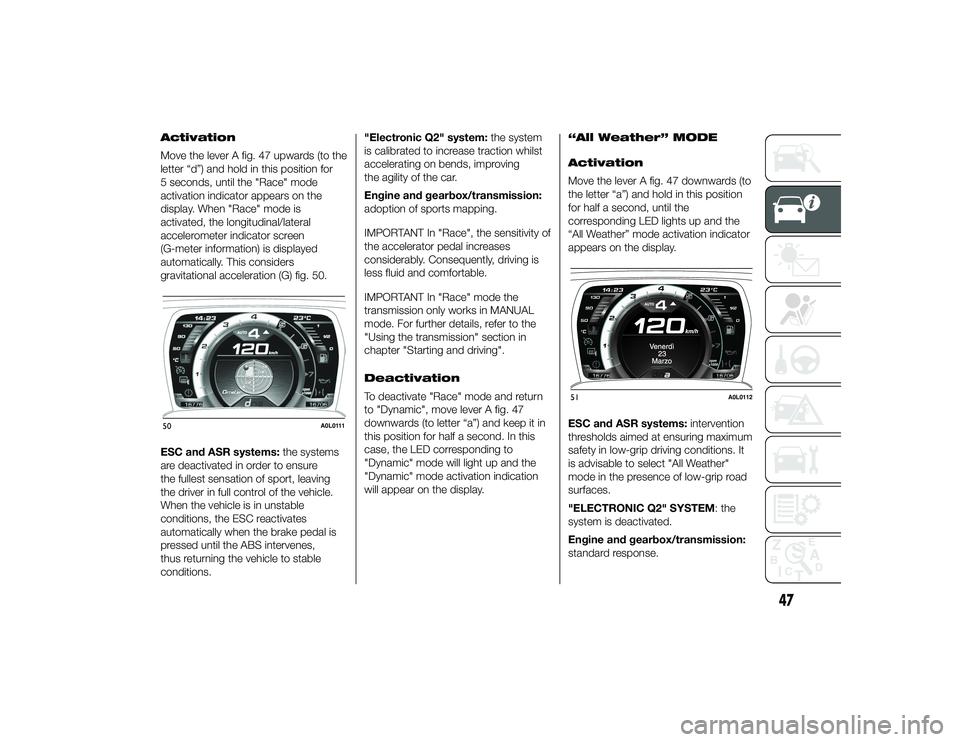
Activation
Move the lever A fig. 47 upwards (to the
letter “d”) and hold in this position for
5 seconds, until the "Race" mode
activation indicator appears on the
display. When "Race" mode is
activated, the longitudinal/lateral
accelerometer indicator screen
(G-meter information) is displayed
automatically. This considers
gravitational acceleration (G) fig. 50.
ESC and ASR systems:the systems
are deactivated in order to ensure
the fullest sensation of sport, leaving
the driver in full control of the vehicle.
When the vehicle is in unstable
conditions, the ESC reactivates
automatically when the brake pedal is
pressed until the ABS intervenes,
thus returning the vehicle to stable
conditions. "Electronic Q2" system:
the system
is calibrated to increase traction whilst
accelerating on bends, improving
the agility of the car.
Engine and gearbox/transmission:
adoption of sports mapping.
IMPORTANT In "Race", the sensitivity of
the accelerator pedal increases
considerably. Consequently, driving is
less fluid and comfortable.
IMPORTANT In "Race" mode the
transmission only works in MANUAL
mode. For further details, refer to the
"Using the transmission" section in
chapter "Starting and driving".
Deactivation
To deactivate "Race" mode and return
to "Dynamic", move lever A fig. 47
downwards (to letter “a”) and keep it in
this position for half a second. In this
case, the LED corresponding to
"Dynamic" mode will light up and the
"Dynamic" mode activation indication
will appear on the display. “All Weather” MODE
Activation
Move the lever A fig. 47 downwards (to
the letter “a”) and hold in this position
for half a second, until the
corresponding LED lights up and the
“All Weather” mode activation indicator
appears on the display.
ESC and ASR systems:
intervention
thresholds aimed at ensuring maximum
safety in low-grip driving conditions. It
is advisable to select "All Weather"
mode in the presence of low-grip road
surfaces.
"ELECTRONIC Q2" SYSTEM: the
system is deactivated.
Engine and gearbox/transmission:
standard response.50
A0L0111
51
A0L0112
47
24-9-2013 11:49 Pagina 47